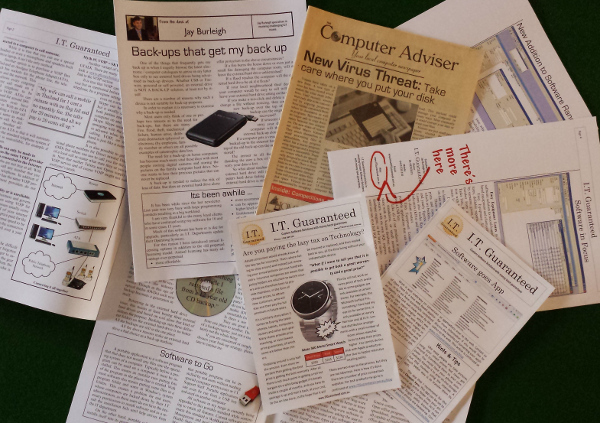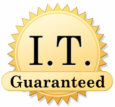continued from “Are paper newsletters better than mailing lists”

Regardless of the type of newsletter you opt for, here are some tips to ensure yours gets read, and remembered.
Tips for your Tech Newsletters
- Stand out. Have a lead story. It should be topical. It shouldn’t be about your business. Viruses are always good. Try dispelling common myths.
- Play with your headlines. Go for a double meaning or just be corny. Here are a couple you can use. “What gets my back up” for an article about backup mediums. “Sync or swim” for articles about syncing pictures from your mobile or maybe about dropbox. How about “Hostage Rescue Hero” for an article about how you saved a business from ransomware.
- Be bold. If you have a viewpoint that is controversial, back yourself. Spell out your arguments. Mention opposing points of view and state why yours is valid. People will remember you for longer than just another post that conforms with the current accepted viewpoint.
- If printing, it doesn’t have to be glossy. In fact, recycled paper can be cheaper, unless opting for that crafty kind with the flecks in it. In the footer, add a statement to the effect of “We use recycled paper, which is better for the environment. However, if you would like to sign up for our electronic version …”
- Find your voice. Be genuine. When I write, I have a particular individual in mind that I’m writing for. For residential, it is an early client of mine. Someone who is interested, can follow logic, who might have once worked in an office. For business, I have a similar client in mind, with different needs. I never assume that they know more than the absolute basics, so I spell things out before going into detail.
- Be humorous, fun, use slang expressions if that’s your voice. It shows you’re human, too. In my first newsletters, I used to place I.T. jokes and quotes in the margins at 90 degrees to the text, similar to those little margin gags in MAD magazine. If you drop a funny comment into a serious topic, it does a number of things. It makes the reader want to read more. It alleviates tension and relaxes the reader. When they are relaxed, they are more receptive to your message. It also proves to them that you are human, and not one of those tech robots. One of the funny ones. Someone other people want to be around, too.
- Break up text with sub headings and never be afraid of white space.
-
Make use of standout quotes and callout boxes for your important points.
- Never, ever call it a newsletter. Never refer to it as a newsletter. It can be an update, a warning, a how to guide, a comparison, free advice. The heading, or subject line if an email, should contain the topic of the newsletter. (Hey, I didn’t say you couldn’t use the word internally.)
- Even paper-based newsletters should have a call to action. Make sure you include all of your contact details and the various ways people can reach you.
- Use it as a flyer, or with a flyer, put together an information pack for new clients and prospects.
- A newsletter should contain only a couple of articles, two to three is perfect. It should have a lead article. This should be the reason you are sending the item formerly known as a newsletter. One article should be informative such as how to guides, or consultative product recommendations or reviews. One article should be newsy, such as info on a current virus. The last article might be about your firm, such as a new service, update or award. If, however, you win a Nobel prize, you have my permission to lead with that story instead.
- Don’t put a date on it. Recycling is in and you never know when you will have time write another newsletter. Don’t even put a month, season or year on it. I could recycle an article I wrote on viruses from twenty years ago, almost word for word.
- Reproduce every article that is in the newsletter to your blog. If you are time poor, then just a cut and paste will do. Otherwise, add in a few appropriate links, and optimise for search engines. All this should keep the Google juice flowing.
- If you have too much to say in your paper newsletter, then add a note to say the article is continued on www.MyCompany.com/blog. Bonus points if you can get the ‘to be continued’ message just before you give the secret that was promised in the preceding paragraphs.
- Have your newsletter proof read. There are lots of proofreaders on Fiverr. I am happy to recommend one: https://www.fiverr.com/flick_boyd. When you find a proofreader that gets you, keep them. But make sure you go through the edited document and accept or reject each change individually. They don’t always know what emphasis you might be after, or they might alter your tone.
Tips for pictures
- Pictures say a thousand words. They also can be enlarged to fill the page or shrunk to get that last sentence in. Get an account with a stock image website. Articles with pictures are more likely to be read than page-down after page-down of plain text.
- Avoid stock images with stock people. To this end, if you must use stock people, avoid any stock image of business people on the first, say, 1000 pages of a search. It is much better to use a photo of yourself. If you consider yourself so ugly that you do not want to use a picture of yourself, try a picture of your van with your signage.
- Cartoons can be used instead of photos if they are on topic. You don’t need to be serious all the time. Cartoons also help to avoid using stock images of people. Cartoons are available at the same stock image websites. Just search for “cartoon” before the topic you are searching for. For example, “Cartoon computer virus”
- When using images, including cartoons, that have people in them, the person should face into the text. This draws your reader towards the text rather than towards the margin of the page.
Frequency
- I am going to disagree with those blogging advocates that recommend a regular schedule of updates. Regular updates might be great for podcasts, but I like the element of surprise for a newsletter. I want to catch my prospects, or clients, unaware, unprepared and with their guard against marketing down.
I like to update clients when I have something to say rather than say something about nothing.
This rules out emailing them monthly. But the moment another ransomware attack hits, have your update ready to go. The advantage of this method is that your readers get to know that, when you have something to say, it is important, and they should take the time to read it, lest there be consequences.
My Experience
I have found using paper-based newsletters have kept my clients loyal, educated and in mind when an I.T. problem or question arose. The newsletters are particularly well-received by existing customers. If you choose to hand deliver them, it is another way, or even an excuse, to stay in touch with your existing clients, or meet new ones. They can be a conversation starter. After all, people prefer to do business with someone they know.
If you are having trouble building an email list, particularly with today’s anti-spam laws, a printed newsletter can be the solution.



